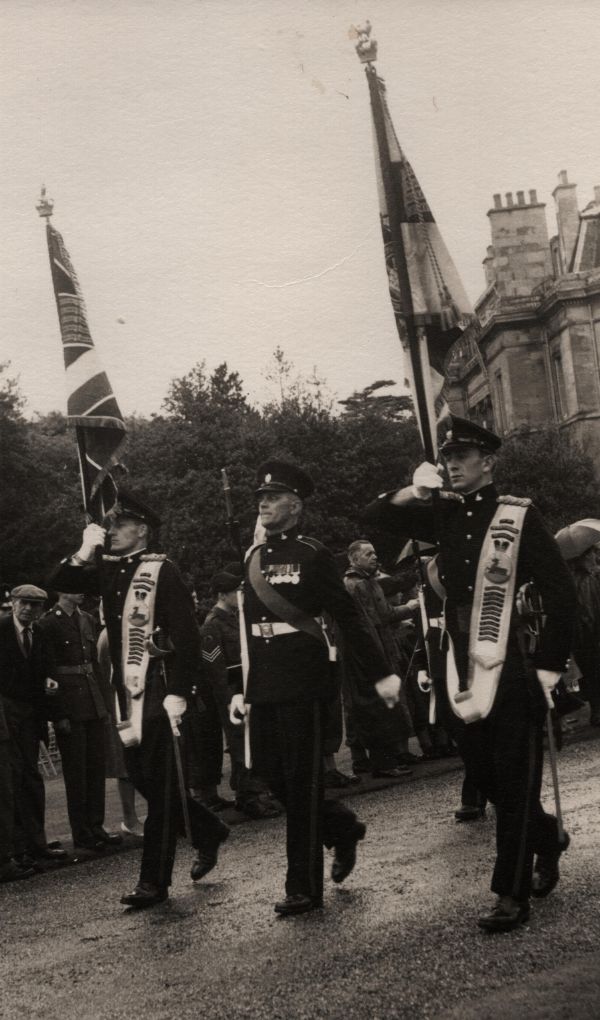Home » The Story Of The Regiment »
Descendants of the Hertfordshire Regiment
1st Battalion The Bedfordshire and Hertfordshire Regiment 1961-1967
Battalion HQ and HQ Company were stationed at Hertford, with the Corps of Drums continuing its long association with Ware. The new regiment carried the battle honours of both its predecessor regiments. When it came to uniform and badges, a committee of serving and retired officers was convened to make recommendations. They did not favour using the old Beds & Herts badges but wanted to incorporate the histories of both the 1st Herts and the 5th Beds. The new badge incorporated the eagle and castle (symbol of the Borough of Bedford) used by the Bedfordshire Rifle Volunteers in the 19th century, and the hart lodged of the 1st Hertfordshire Regiment. The colours of both predecessor regiments were carried until 1963 when Colonel in Chief Queen Elizabeth The Queen Mother presented new ones (The 1st Hertfordshire Regiment Colours were finally laid up in All Saints Church, Hertford in 1967).
By 1965, it had become clear that drastic reform of the Territorial Army was due to take place, with fewer units, based in towns and cities where greater recruitment was more likely to take place. Hertford was not likely to be one of these centres, however, the decision to retain a Territorial Force for Home Service, provided a solution as the 1st Bedfordshire and Hertfordshire Regiment were allocated to this role.
The Bedfordshire and Hertfordshire Regiment (Territorial) 1967-1971
In April 1967, the regiment was transferred to Category III of the territorial and Army Volunteer Reserve. It was designated The Bedfordshire and Hertfordshire Regiment (Territorial) and absorbed part of the 286th (Hertfordshire and Bedfordshire Yeomanry) Field Regiment and the Royal Artillery. There was no HQ Company, but Regimental HQ, Reconnaissance Platoon and No. 1 Company were based at Hertford with Companies 2 to 4 at Hemel Hempstead, Luton and Bedford, which also hosted the Pioneer Platoon. There were no longer any outlying detachments and the drill halls at Watford and Ware were closed.
Volunteers continued to wear badges and uniforms of their predecessor regiments and the Colours presented in 1963 were carried. Category III units were poorly equipped in comparison to Categories I and II, with the Regiment managing on No. 4 rifles and battledress whilst their Category II colleagues were issued with 7.62 mm self loading rifles and combat dress. This added to the difficulty in attracting recruits and with only an eight day annual camp and four paid training days per year, there was little time for effective training.
In 1968, the Ministry of Defence informed Category III units that their future was under scrutiny, and whilst they could continue training, there would be no further funding. This was a huge blow, but the Beds & Herts launched themselves into fundraising with raffles and jumble sales as well as charging members for attendance rather than paying them.
Later that same year, authority was given for the raising in Hertfordshire of an additional company for 5th (Volunteer) Battalion The Royal Anglian Regiment. Handover was completed in March 1969 when the Bedfordshire and Hertfordshire Regiment (Territorial) was disbanded. It was not until B Company, 6th Volunteer Battalion The Royal Anglian Regiment was formed at Bedford in 1971 that the Colours of the Beds & Herts were handed over and paraded for the last time. They were finally laid up in St Albans Abbey in 1980.
No. 4 (Hertfordshire) Company, 5th (Volunteer) Battalion The Royal Anglian Regiment 1967 – 1996
This Battalion was raised in Category IIA of the Territorial and Army Volunteer Reserve in 1967. Each Volunteer Company was associated with the Regular Battalion of its recruiting area and wore its collar badge. At this time Hertfordshire was not represented within the battalion. In 1969, the 5th Battalion were authorised to recruit to 140% and raise a n additional Company of two rifle platoons and an anti-tank platoon in Hertfordshire. The new company, designated No. 5 Company took over the drill halls vacated by the Beds & Herts and recruited many of its former members.
In the late 1970s, reorganisation of the British Army in Germany and NATO units of both Regulars and Volunteers scheduled to travel to the Continent saw the 5th and 7th Volunteer Battalions included in the Order of Battle of 7th Field Force. As such, the 5th took part in several large reinforcement exercises, including Lionheart in 1984, the biggest peace time exercise conducted by the British Army at that time. In 1996 the 5th Battalion was converted from an infantry battalion to a transport role and it was designated 158 Regiment Royal Logistics Corps. The 5th Battalion Band were retained as the Band of the Royal Anglian Regiment (TA).
3rd Battalion, The Royal Anglian Regiment – The Steelbacks 2006 to date
Today the Royal Anglian Regiment is formed of two Battalions with a third light infantry army reserve Battalion, nicknamed The Steelbacks. Headquarters are in Bury St Edmunds, but a Company detachment remains at the Army Reserve Centre in St Andrew Street, Hertford.










